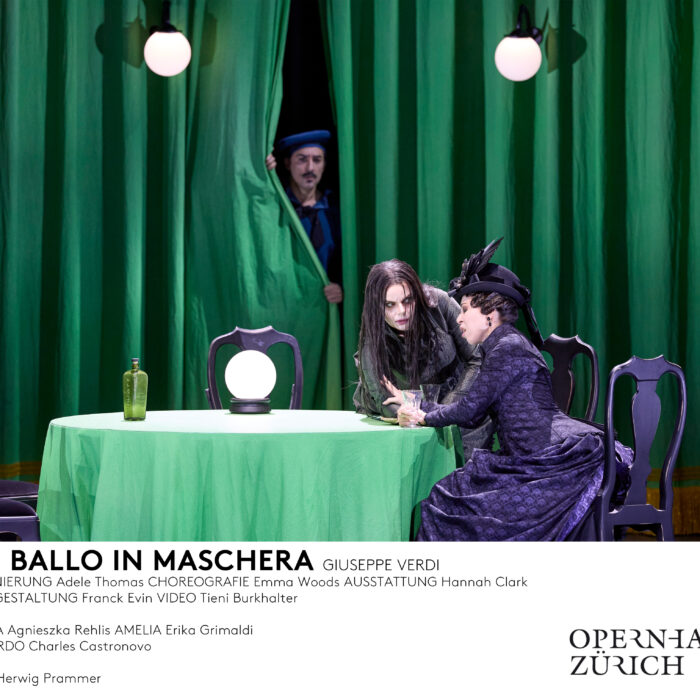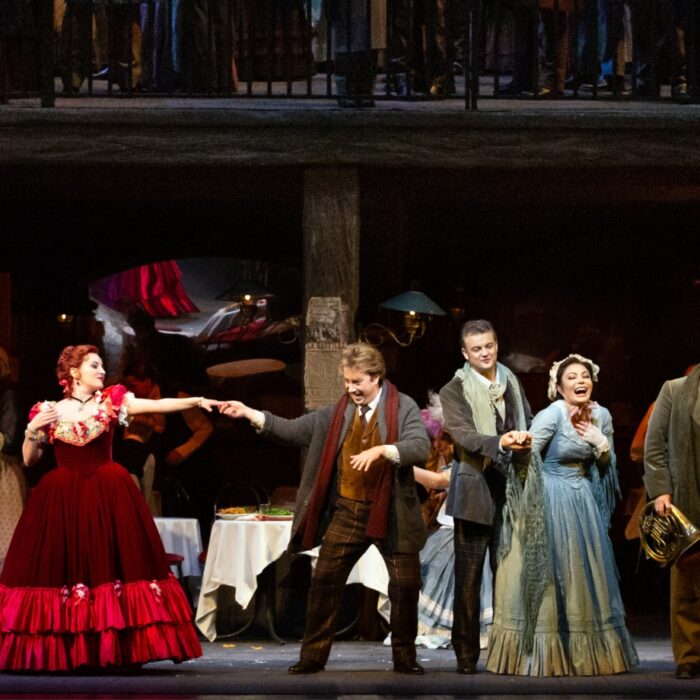
OPERA America 2023 Review: Reminiscence – Alison Saporta & Felix Jarrar in Recital
By Chris RuelOn August 30, 2023, soprano Alison Saporta took to OPERA America’s Scorca Hall stage in New York City, showcasing her artistry as a recitalist. Beside her, collaborative accompanist Felix Jarrar impressed on the piano, exhibiting his talents as a composer with a new song cycle and an intriguing toccata and fugue inspired by a theme from Mozart’s Requiem.
Saporta, a recipient of many accolades, has enriched her craft by participating in masterclasses led by industry luminaries like Michael Fabiano and Christine Goerke. She has also honed her abilities in Angel Blue’s Opera Training Studio. At the same time, Jarrar boasts a rich portfolio as a composer, pianist, vocal coach, and orchestrator, currently affiliated with Mannes School of Music in New York. This summer, his orchestration talents were displayed, orchestrating Hogfish’s “Carmxn,” a fresh take on Bizet’s iconic “Carmen.”
Saporta and Jarrar curated a diverse program featuring works by Schumann, Heggie, Mozart, and Barber. Jarrar’s song cycle and toccata and fugue further enriched the program. True to the recital’s theme, every piece resonated with reflection, evoking memories of love or echoing the nostalgia of days past.
Schumann Lieder
The program began with three pieces from Schumann’s “Myrthen,” composed in 1840. Featuring 26 lieders, the cycle was Schumann’s touching wedding present to his fiancee Clara Wieck.
“Widmung” (Dedication), with words by Rückert, emerged as the standout of the “Myrthen” cycle, celebrated for its deep portrayal of marital affection. Clara considered it her favorite of her husband’s lieder compositions.
Schumann’s composition is a blend of musical intricacy and profound sentiment. It begins with dynamic broken chords, pushing the lieder’s momentum before transitioning into a contemplative realm with the phrase, “you are repose, you are peace.”
The piece spanned a tessitura from a B on the low end to an F up top. While Saporta maintained stability across this range, the low B appeared to be her boundary at the bottom. Her F sounded robust and resonant, suggesting potential for even higher notes in her register.
Concurrently, Jarrar skillfully maneuvered through pages filled with arpeggios and the diverse musical emotions Schumann employed to convey his affection for Clara.
“Der Nussbaum” (The Nut Tree) showed how the piano and the singer can converse, with the piano repeating a five-note motif, answering the singer’s sentences about nut tree blossoms.
Saporta sang with genuine feeling, especially when breathing the word “Flüstern” (whisper), making Heinrich Heine’s words even more powerful. And again, Schumann had Jarrar working hard, playing non-stop arpeggios on the lower keys.
Next up was “Du bist wie eine blume” (you’re like a flower), the briefest of the Schumann songs. Short but sweet, the tune is chordal, shifting softly between piano and mezzo-forte moments. Saporta’s singing felt like a soft wind moving through flowers. Jarrar played the piano serenely, pressing the keys gently even when playing louder.
R-r-rar!
Saporta and Jarrar presented “Animal Passion,” from Jake Heggie’s “Natural Selection” cycle, with lyrics by Gini Savage.
Heggie uses the piano to bring the poet’s words to life. The music jumps with “Bobcats springing…” and feels like a sweeping motion with “…a love to sweep me off my feet”, and so forth.
The song paints a picture of someone full of fiery desire, not wanting a calm love life (“…a fat domestic cat”), but a wild one with no limits.
Even if you’re not used to modern classical music, Heggie makes it accessible. His music gives listeners something solid to hold on to, even if it’s not always a traditional tune. The composer inserts an intriguing tango rhythm that serves a dual purpose: providing playfulness and adding to the accessibility.
Saporta delivered the song with enthusiasm. She playfully whispered the phrase “pussy foot,” almost as if giving a cheeky wink. In the song’s ending line, “let the voyeurs voient…” Saporta showcased her control, holding and stretching a soft note with remarkable steadiness.
For the Love of Vampires
Jarrar introduced his song cycle, “Vampire Delights.” In this series, the central figure forsakes mortal love, marred by repeated letdowns, in favor of the eternal love promised in the undead’s realm.
The first segment, “Delusional Lover,” portrays the protagonist lamenting the endless disappointments endured in earthly love. Saporta navigated melismas skillfully. However, her high notes seemed slightly less stable than earlier in the recital. It’s no secret that Jarrar demands much from his vocalists, pushing them into extreme ranges and, in this case, stretching Saporta’s abilities.
“Blood Moon” takes us through the central character’s transformation from a human to a vampire. In this piece, Jarrar sets up a sparse bass line enriched with sparkling sounds in the higher keys, often paired with lyrics that evoke immortality. This marks the protagonist’s shift from despair to hopeful anticipation of a fresh start and potentially a newfound love.
The ultimate piece of the cycle, “Cookie Date,” featured a dramatic entrance by Saporta, wielding a rolling pin which she smacked against her hand, reminiscent of an old-time police officer with a billy club.
Besides challenging singers, Jarrar also has a knack for infusing his compositions with potential double entendres, leaving it to the audience to interpret. While some might see risqué implications in the lines, others could take the lyrical content at face value, imagining a literal indulgence in cookies. But, with the closing line being, “Bite my cookie, baby,” there’s less room for innocent meaning.
Mozart.
After a brief break, the audience was treated to Jarrar’s Toccata and Fugue, inspired by a theme from Mozart’s Requiem. The performance was notably lively, and it’s striking to think of the vast amount of notes Jarrar can recall with lightning speed and accuracy. The particular inspiration was drawn from the Offertorium – Domine Jesu, with the lesser-known segment where the choir sings “Quam olim Abrahae promisisti…” While many are more familiar with the Lacrimosa and Introitus, Jarrar’s choice introduced listeners to a deeper cut from the iconic work.
Switching gears but sticking with Mozart, Saporta retook the stage with “Deh, vieni non tardar” from “The Marriage of Figaro.”
She delivered a lively recitative that felt integrated rather than just a prelude to the far more engaging aria. Clear in her diction and animated phrasing, her aria had a dreamy touch, complementing the rhythmic but gentle piano backing. Even though the piece is traditionally andante, the duo chose a slightly relaxed pace, giving the audience a few extra moments to savor the melodies.
Pairing Barber with Mozart might seem odd, but the dreamy essence of “Deh vieni” gracefully transitioned into Barber’s evocative “Knoxville: Summer of 1915.”
Summer’s Never Over in Knoxville
Using James Agee’s words, Barber’s piece conjures up an idyllic Southern summer: the gentle creaking of rocking chairs, the distant clang of streetcars, and the rhythmic buzz of locusts.
The deep bond between the piece and its performers was clear. This connection became evident as the composition transitioned from its soft beginning through its discordant middle, adapting to the varying tempos. Saporta’s skill was apparent throughout these changes.
Yet, given the demanding nature of the piece and its placement at the end of the program, Saporta’s vocal energy showed signs of waning. This isn’t to say the performance was poor; it was still delivered with skill directly linked to the preparation Saporta and Jarrar undertook to get the piece stage-ready.
In an ideal world, performers would consistently deliver at their peak. But such consistency is a lofty aim. A more practical goal for artists is to connect with the music and the audience. That connection becomes even more crucial when vocal challenges arise – like performing a lengthy, demanding piece towards the end of a recital. And in this, Saporta succeeded. The audience likely departed with vivid images in their minds, masterfully painted by both Saporta and Jarrar. The essence of the summer day that Barber and Agee depicted was captured, internalized, and then shared by the duo. The presentation prioritized emotional resonance over technical perfection, favoring the heart over the ear.



